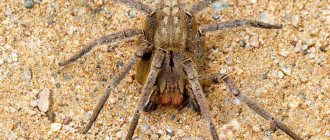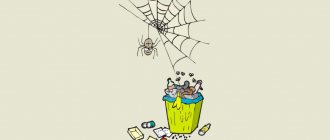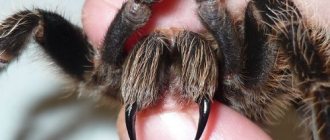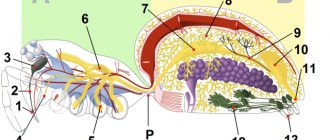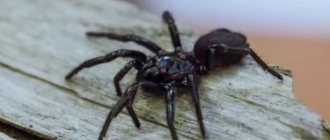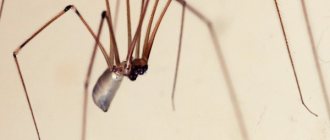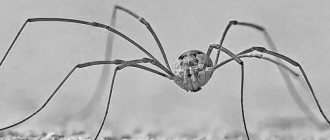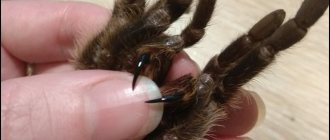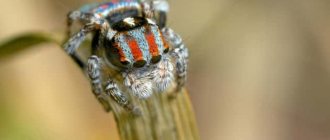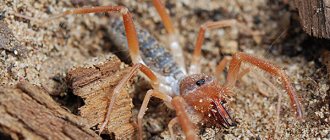Of all the continents of the globe, Australia is perhaps the most amazing and mysterious. Due to its remoteness from other continents, Australia has developed a unique flora and fauna. Of all the diversity of Australian fauna, today we will consider spiders, of which there are more than 10,000 species on the Green Continent. Not all spiders in Australia are poisonous and pose a mortal danger to humans, but meeting them always causes anxiety and wariness even in those who do not suffer from arachnophobia.
List of the most amazing spiders in Australia:
1
Giant crab spider Heteropoda
This type of spider is quite widespread throughout the Australian continent and can be found everywhere. Sometimes they get into the houses of Australians, which causes a lot of trouble for the owners.
A typical large Huntsman spider Heteropoda moves quite quickly, and is capable of covering a distance of one meter in one second. Its size, together with its paws, reaches a diameter of 30 cm, but, despite its terrifying size, they are practically harmless.
They prefer to openly hunt their victims rather than from ambush, as many of their brethren do. They are characterized by non-aggressive behavior and are mainly nocturnal. Note that in 2016, the largest spider in the world, belonging specifically to this type of spider, was discovered in Australia.
2
The most popular spider species in Australia
The territory of this remote continent is home to up to 10 thousand different species of arachnids, but only a few of them are considered the most dangerous and famous.
Garden orb-weaving spiders
Orb weaving spider.
The most common arachnids in Australia are members of the orbweaver family. They got their name due to the characteristic shape of the web they weave, which can be stumbled upon in almost every garden.
Garden orb weavers are not particularly noticeable in size. The body length of different species can vary from 1.5 to 3 cm. The abdomen of the orb-weaving spider is large and round, and the body is covered with hairs.
The colors of orb weavers are predominantly gray and brown. In most cases, Australians are bitten by spiders from this family, but fortunately their bites are practically harmless to humans.
Huntsman spiders
Hunter spider.
The huntsman or huntsman spider is one of the most terrifying representatives of the Australian fauna. These spiders very often penetrate houses and cars, scaring people with their sudden appearance.
Representatives of this species are large and the span of their paws can reach 15-17 cm. The limbs of the huntsman spider are long and powerful. The body is covered with hairs. The color of different species varies from light gray to black.
Huntsmen move very quickly and can cover a distance of 1 meter in a second. Representatives of this family are not prone to aggression and rarely bite people. The poison of hunting spiders does not pose a serious danger to humans and unpleasant symptoms disappear after a few days.
Recluse spiders
Brown recluse spider.
Loxosceles or recluse spiders are rarely found in the path of humans, but sometimes climb inside houses in search of food or shelter. A distinctive feature of this species is the violin-shaped pattern on the back. The abdomen of the recluse spider is small and round. The legs are long and thin. The spider's body can be colored in different shades of brown or gray.
The venom of the recluse spider is considered one of the most dangerous for humans and can lead to serious health problems. But over the past 20 years, not a single serious case of a recluse spider bite has been recorded in Australia. In addition, their fangs are too small and do not allow them to bite through skin through clothing.
Australian tarantulas
Tarantula.
Australia is home to 4 species of large spiders from the genus Tarantula. Native tarantulas are also called "whistling" or "barking" spiders due to their ability to make distinctive sounds.
Representatives of this genus have a large, massive body and legs covered with many soft hairs. The body size including paws can reach 16 cm. The color of the Australian tarantula can be from silver-gray to dark brown.
The bite of these arachnids is considered one of the most painful, since the length of their fangs reaches 10 mm, but the venom of Australian tarantulas very rarely leads to serious consequences for human life and health.
White-tailed spiders
White-tailed spider.
Australia is home to only two species of arachnids, which are called “white-tailed”. These spiders constantly move in search of food, which is why people often encounter them both in the wild and in urban areas.
The paw span of white-tailed spiders reaches only 2-3 cm, and the body is shaped like a cigar. The main color of the white-tailed spider can be either gray or dark red. A distinctive feature of these arachnids is a white spot at the rear end of the body.
According to the latest scientific research, it has been proven that the venom of white-tailed spiders does not pose a serious threat to human life and health.
Mason spiders
Mason spider.
This species was discovered relatively recently. They lead a secretive lifestyle and spend most of their time waiting in ambush for prey near their burrow. The size of these spiders is small and they reach no more than 3 cm in length. The body and legs of the mason spider are colored in gray and brown shades, which help it blend in with its environment, and are also covered with many hairs.
Almost all people bitten by mason spiders are victims of male spiders. This is due to the aggressiveness of males and their tendency to wander in search of a female. The venom of representatives of this species is not dangerous to humans and rarely causes harm to health.
Mouse spiders
Mouse spider.
This type of arachnid can be found almost throughout Australia. A distinctive feature of mouse spiders is their activity during the daytime and their bright appearance. Their body and limbs are painted black. The head and chelicerae of males are bright red. These spiders are small in size and can reach a length of 1 to 3 cm.
The composition of the venom of mouse spiders is similar to the venom of dangerous representatives of the funnel web family, so their bite can pose a serious threat to human health, and can be fatal for children and allergy sufferers.
Redback spider
Australian widow.
The redback spider is also called the Australian widow spider. Representatives of this species are brothers of the famous black widow and produce a dangerous neurotoxic poison.
The Australian widow is very similar to her “black” sister. Its distinctive feature is a bright red stripe on the back. The body length of the redback spider does not exceed 1 cm, while males are two to three times smaller in size than females.
The bite of spiders of this species can be deadly for children, the elderly and people with weak immune systems, and in a healthy, adult person, the red-backed spider can cause serious illness.
Sydney leucopaweb (funnel web) spider
This type of arachnid is considered one of the most dangerous in the world. From its name it is clear that its habitat is concentrated near the city of Sydney. Representatives of this species are medium in size. The body length of the Sydney funnel-web spider can reach 5 cm. The body and legs of the animal are painted black or dark brown.
Sydney funnel web spider.
This species is considered particularly dangerous due to the high toxicity of the poison and aggressive behavior. When attacking a person, spiders of this species tend to make several bites in order to introduce as much poison into the victim’s body as possible. Moreover, its chelicerae are so strong that they can even pierce the nail plate of an adult.
If you are bitten by a Sydney leukoweb spider, you should immediately seek medical attention and administer an antivenom. The dangerous toxin from this species can kill a small child in just 15 minutes.
Nephilic orb weavers
The spiders, collectively known as Nephila, which is Latin for "weaving-loving", are known by a variety of names in Australia. They are called both Banana spiders and golden spiders, and due to their large size you can often hear the name - large tree spider.
Relatively small in size, the spiders, growing from 2 to 4 cm, skillfully weave webs, which sometimes even trap small birds. Their venom is strong enough to kill prey, but is completely harmless to humans.
Interestingly, fishermen weave nets from representatives of the genus Nephila, and thus catch fish on the ocean coast.
By the way, on topcafe.su there is a very interesting article about the most poisonous insects on the planet.
3
Black house spider
The name of this spider already indicates that they can often be found in residential areas. Badumna insignis is found throughout Australia and spends most of its time in its funnel-shaped web.
They usually live on tree trunks, under stones or on the walls of house buildings. In houses they set up their own web traps near windows or doorways. But you can also find cobwebs in the corners of the room.
It will never attack a person first, but after the bite a groove remains, and the bite site is accompanied by painful swelling.
4
Huge webs
When it rains, arthropods are blown into trees by the wind. Spiders climb higher and weave an elastic web. There are a lot of arthropods, and they can rise into the air to a height of 3 km and cover long distances. As a result, the webs are simply huge.
Spiders also cover large areas with them during floods. Trying to avoid water, they climb to the top of the blades of grass and from there release large plumes of web, trying to get to safety with the help of the wind.
As a result, all fields and objects end up under a thick white “cover.” As soon as the flood ends, the arthropods return to their original habitat.
Spider season is an amazing phenomenon in Australia, when you can observe large concentrations of arthropods of different species and huge webs of cobwebs. Since some of them are poisonous, after a bite you should immediately go to the hospital. Cases of death are practically eliminated, since an antidote has been developed for each species.
Mouse spider
Photo source: / CC BY-SA
The mere appearance of this spider can cause awe, and most importantly, frighten even the bravest daredevil. This is one of the representatives of the large Missulena species, and these spiders are distributed throughout Australia.
They live in the ground, digging small holes for themselves, but, interestingly, they make two entrances, thus ensuring their safety. The strong jaws and strong legs of mouse spiders allow them to hunt fauna representatives much larger than themselves.
Their bite is painful, and the injected venom can harm human health, but pharmacists have long come up with a successful antidote.
5
How dangerous are Australian spiders?
Despite popular belief, most spiders living in Australia do not pose a serious threat to human life and health. The majority of arachnids on this continent have a low-toxic poison that can cause only short-term unpleasant symptoms:
Are you afraid of spiders?
TerribleNo
- pain at the site of the bite;
- redness;
- swelling;
- itching;
- burning.
However, not all spiders in Australia are considered harmless. The country is home to several truly dangerous species. Fortunately for local residents, thanks to the high level of medicine and antidotes created in the second half of the last century, the number of deaths after being bitten by dangerous spiders was reduced to zero.
Wolf spider
A spider lives in the vastness of Australia and has such an exotic name, although it is known to science as Lycosidae, which literally means “wolf” from ancient Greek.
The length of the body does not exceed 30 mm, and you can meet this amazing spider with long legs in any corner of Australia. They feed on beetles, but are not averse to eating flies if they catch them.
Calm, non-aggressive predators living in burrows rarely attack people. But in moments of danger they can bite painfully, although the poison released during the bite is not dangerous to human life.
6
Mason spider
Photo source: / CC BY-SA
They are also called digger spiders, as they dig holes in the ground and, camouflaging them, wait for their prey to be ambushed. They belong to atypical tarantulas and have quite toxic poison.
They grow from 1.5 to 3 cm and lead a measured lifestyle, rarely attacking humans. Males can show some aggression, but only in moments of danger. When bitten, local swelling occurs, and sometimes the poison, if it enters the human body, can cause dizziness, nausea and vomiting.
They are social animals and live mostly in colonies.
7
White tail spider
Photo source: / CC BY-SA
This amazing spider has a white spot on its reddish-brown abdomen. In Australia, there are two species of similar spiders, which are scientifically named Lampona cylindrata and Lampona murina.
It is quite difficult to distinguish them without special training, and perhaps many of the species are simply not identified. White-tailed spiders do not weave webs, but pursue prey at night.
One of the few Australian spiders that eat their own kind, and the list of their victims is topped by the black house spider.
8
Jumping spiders
Unusual animals from the huge family of araneomorphic spiders have adapted to live in any natural zone and climatic conditions. For this reason, they literally occupied the entire country.
They are distinguished by good eyesight, which helps them hunt, looking out for prey. Of course, how can you see poorly if you have 8 eyes, located in three rows?
The eyes also serve for navigation in habitats. Jumping spiders vary in body color, and adult specimens do not grow more than 4 centimeters in diameter.
Australian tarantulas
Tarantulas are found on many continents of the planet, but it is in Australia that these spiders are the largest. Together with their paws, some species reach 23 cm in length, and their fangs grow up to 1 cm and have a rather menacing and frightening appearance.
The most unique species is Selenocosmia, locally called the "Queensland whistling tarantula" because it makes an unusual hissing sound.
As you can see in the photo, this type of hairy spider, like all tarantulas, grows to impressive sizes, and their bite, although not fatal to humans, is quite painful and causes discomfort.
10
What are the sizes of spiders living in Australia?
There is an opinion in the world that Australia is inhabited by spiders of extremely huge sizes. In fact, this is not true at all. In fact, most species living on the continent are small in size, and particularly large individuals are quite difficult to find.
In general, the number and size of arachnids on the distant continent are practically no different from the inhabitants of other hot countries.
The main reason for the spread of the myth about giant Australian spiders was the huge species diversity and the most favorable conditions for their development.
Loxosceles
The terrifying appearance of this recluse spider and its photographs on the Internet have given rise to a stereotype about the danger of the Loxosceles species. But, as scientists assure, this creature with long legs and a small body is not that dangerous.
True, after its bite, the wounds take a long time to heal, and the poison is toxic and leads to allergies. But these spiders rarely attack people, and so far no victims of a Loxosceles bite have been recorded in Australia.
In addition, this species is small in number; hermit spiders live only in certain areas of the mainland, far from populated areas, so meeting them is very difficult.
Antidote for spider venom
An antidote for spider bites was developed in 1980. An interesting feature of the venom of these predators is that it is not dangerous to animals - cats, dogs and many other creatures may not be afraid of them. Scientists use this property to create an antidote. They extract toxins from arthropod venom glands and inject them into the rabbits' bodies. Venom-resistant animals produce antibodies and their blood subsequently becomes the main component of the antidote.
Leukoweb spiders are being used to create an antidote
Interesting fact: scientists still don’t know why evolution decided that the venom of leukoweb spiders is dangerous only to humans. Perhaps this is a special protection from us and creatures like us.
Dolomedes briangreenei
Photo source: Twitter @bgreene
More recently, a new species of spider was discovered in Australia, which received the Latin name Dolomedes briangreenei. This is so far the only known spider in Australia that can swim and skillfully hunt fish.
Scientists have found that it prefers to live on the shores of freshwater bodies of water and streams near Brisbane. In the same Australian city, a new spider was introduced to the world.
With the help of its hind pair of paws, it quickly moves along the surface of the water, and when it sees prey, it immediately dives and captures its victim. Then he pulls the fish ashore, and only when he is on the ground does he eat the prey.
12
How common are spiders in Australia?
Australia is home to many spiders. The climate of this country is perfect for them and contributes to their spread throughout the continent. In addition, due to the long-term isolation of this continent, many species of animals living on its territory are unique.
Spiders in Australia can be found both in the wild and indoors.
Most of them are active exclusively at night, so during the day they try to hide in a safe place. Residents of Australia often encounter spiders in the following places:
- attics;
Australia is a spider-friendly place.
- basements;
- mailboxes;
- space behind cabinets or other furniture;
- dense thickets in gardens and parks;
- inside bags or shoes left outside at night.
Redback spider
Among the poisonous spiders, a special place on the Australian continent is occupied by the red-backed spider, known to science under the Latin name Latrodectus hasselti.
It can be easily distinguished by the characteristic red stripe running along the upper surface of the body. It has the most powerful venom of all Australian spiders. The bite causes systemic damage and in some cases can lead to death.
This beautiful but dangerous spider is on the list of animals that exhibit sexual cannibalism. After mating, the female eats her partner to restore energy for bearing eggs.
13
Tree Funnel Spider
Photo source: / CC BY-SA 3.0 AU
This species of spider, which has the Latin name Hadronyche formidabilis, lives in the northern regions of the continent and is characterized by quite impressive sizes up to 5 cm and toxic poison.
After a bite, severe intoxication of the human body occurs, and statistics show that every year 30–40 people are attacked by this aggressive spider.
The spider feeds on everything that lives near its habitat, and can even eat frogs. But the main diet consists of beetles and other small insects.
14
Nutrition
Thanks to its impressive size, the predator can diversify its diet not only with small insects, but also with quite large animals.
The basis of nutrition is:
- mice, as well as other rodents.
- Small lizards, frogs.
- Comparable in size.
- Insects (cockroaches, beetles, flies).
When attacking a prey, a predator immediately injects poison into its body. The substances it contains instantly paralyze the insect or frog, preventing resistance.
Simultaneously with the poison, the crab spider introduces enzymes contained in the saliva into the body of the victim. Their task is to soften the insides, preparing the prey for eating.
Since crab spiders became known to the world, many cases of attacks by these creatures on small reptiles and rodents have been recorded.
Thus, in the Australian city of Coppabella, a large representative of this species caught a mouse. The size of the animal’s body was comparable to the body of the spider itself, which did not stop it from lifting its prey up the vertical wall of the refrigerator.
An interesting incident happened in the Australian city of Queensland. A couple preparing for Sunday dinner discovered a crab spider hanging from the living room window. The insect was one of the largest representatives of its genus and was the size of a dinner plate. The owners of the house managed to record how he successfully attacked and ate a long gecko, the size of a spider itself.
Sydney leukoweb spider
One of the most dangerous spiders on the planet, the Sydney leukopachine spider is the only representative of the genus Atrax. TopCafe.su does not want you to accidentally find yourself in close proximity to such a “handsome guy”.
It has a very aggressive disposition, and unlike its relatives, which would prefer to avoid confrontation, this spider will attack and seek to bite. In addition, he has fangs with which he bites into his prey.
There have been several cases in history where, after being bitten by this spider, a person died within 30 minutes. But today there is an antidote that has reduced the risk of death.
?
Why are they dangerous?
Spider season in Australia is the time when most species, both harmless and poisonous, are active, but not all of them are dangerous. For example, a horse eats plant foods. The remaining spiders are predators and eat insects and small amphibians. They kill the victim with poison, but in most species it does not pose a danger to humans.
A bite from another group of arthropods can cause flushing, mild cramping, dizziness and nausea. It’s worse if a person has an allergic reaction and develops Quincke’s edema. This is a dangerous condition that can be fatal. However, death from spider bites is now rare, since antidotes have been developed for each species.
After an arthropod attack, you need to remember what they looked like (it’s better to catch a sample and bring it with you) and contact the nearest medical facility. Also, large spiders can be very scary when they hide in cars. If they suddenly come out while the car is moving, the person may lose control, which leads to accidents.
